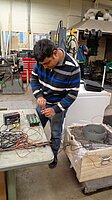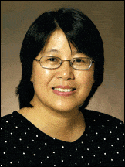Snowmelt water infiltration into frozen soil in Red River of the North Basin

Debjit Roy is a Ph.D. graduate student in the Agricultural and Biosystems Engineering (ABEN) program at North Dakota State University (NDSU). He achieved his undergraduate degree in Agricultural Engineering from Bangladesh Agricultural University and earned his M.Sc. Engineering degree in Water Resources Engineering from Bangladesh University of Engineering and Technology. He is currently doing research on infiltration and soil-water-temperature interaction in frozen soil. His research findings will be used to develop a snowmelt water infiltration model.
Email: debjit.roy@ndsu.edu
Fellow: Debjit Roy
Advisor: Xinhua Jia, Ph.D., P.E.; Associate Professor, Department of Agricultural and Biosystems Engineering, North Dakota State University.
Degree Progress:Ph.D. in Agricultural and Biosystems Engineering, expected graduation Fall 2016
Snowmelt water infiltration into frozen soil in Red River of the North Basin
Snowmelt water infiltration into frozen soil is an important but complicated process that can affect surface water runoff and groundwater recharge. Many factors, such as soil moisture, soil temperature, water release rate from the snow cover, energy content of infiltrating water, porosity, soil cracks, presence or absence of macropores and also complex processes of heat and mass transfer through the frozen soils affect the total infiltration process into frozen soils. In northern hemisphere, nearly 60 percent of the land surfaces are seasonally frozen and North Dakota is a part of that area. There is no simple and clear answer on how water infiltrates into frozen soil. The lack of understanding of the infiltration process into frozen soil is the major limiting factor affecting spring flood forecasting. In recent years, during the spring flood events in the Red River of the North Basin (RRB), flood forecasting cannot be estimated accurately due to lack of data on infiltration into frozen soil. Any error in flood prediction can cause significant financial losses and threaten 200,000 people lives in the Fargo-Moorhead metro area as well as people and animals in the entire basin. The proposed research project will focus on snowmelt infiltration characteristics into frozen soils. A snowmelt water infiltration model will be developed which can help to overcome the current obstacles in order to accurately predict spring flood.
Project Objectives:
The research project will focus on snowmelt infiltration characteristics into frozen soil. The specific objectives of the research study are:
- To measure infiltration amount/rate into frozen soil at field and laboratory conditions.
- To develop a snowmelt water infiltration model based on historic, laboratory and field data.
- To evaluate model outputs with other available infiltration models.
Progress:
Field infiltration measurements: Hydra Probe II sensors for soil moisture and temperature measurement, SR50A Sonic ranging sensor for monitoring snow depth, and modified TE525 rain gage for rainfall and snow fall measurement are installed in the field. Three wireless weather stations were also set up in the research site to collect weather parameters like air temperature, relative humidity, solar radiation, wind speed and direction. A Cornell sprinkler infiltrometer is now being calibrated and tested in field for infiltration measurement. Infiltration tests were done in different research fields in North Moorhead, Clay County, MN and Fairmount, ND during early spring and late Fall of 2015. At least 60 minutes infiltration tests were conducted in each test run by using Cornell Sprinkler infiltrometer. Few Min disk infiltrometer tests were also done in Fairmount site during Fall 2015. Soil moisture and temperature data were collected from sensor data logger after each field experiment.
Laboratory experiments: A frozen soil column experiment is on-going this spring 2015. Two wooden boxes (approximate dimension: 50 x 50 x 30- cm) were made to fill with soil collected from one of the experimental sites. Soil moisture and temperature sensors (5TE, Decagon devices) were setup at 10, 15 and 30 cm depth. Every time wooden boxes with soil were frozen in a freezer until the temperature reached below 0°C. Long duration infiltration experiments were conducted with Cornell Sprinkler infiltrometer and soil moisture and temperature data were collected in a datalogger. A relationship between infiltration amount and rate, soil moisture content, soil hydraulic conductivity and soil moistures will be established from those laboratory experiment results.
Significance:
Understanding the infiltration process into frozen soils could have a broad impact to the hydrological field for the entire and especially in permafrost regions. It would help to better understand the runoff processes and flooding events in winter and spring. Properly adjusted numerical infiltration model could be used to predict actual runoff peaks to prevent damage from floods or to prevent overestimation of runoff. The benefit from this proposed study will be several million dollars each year in flood preparation.
Conference/Seminar Presentations:
Roy D., X. Jia, D. Steele and T. DeSutter. 2014. Soil water release curve development by field and laboratory setups. ASABE Intersectional Meeting, 28-29 March 2015, Brooking, SD.
Jia X., J. Ransom and D. Roy. 2014. Prediction of phonological development and maturity of two corn hybrids in eastern North Dakota. 2014 ASABE Annual International Meeting, 12-16 July, 2014, Montreal, Quebec, Canada.
Roy D., X. Jia and D.D. Steele. 2015. HYDRUS model simulation of infiltration rates into undrained and tile drained soils. North Central ASABE Conference, 10-11 April, 2015, Fargo, ND.
Roy D., X. Jia, D. Steele and X. Chu. 2015. Measurement and simulation of infiltration rates into undrained and subsurface drained soils. 2015 ASABE Annual International Meeting, 26-29 July, 2015, New Orleans, LA.

Xinhua Jia, P.E., Professor
Morrill Hall Room 204
Department of Agricultural and Biosystems Engineering
North Dakota State University
NDSU Dept. 7620PO Box 6050
Fargo ND 58108-6050
Phone: (701) 231-6453
E-mail: xinhua.jia@ndsu.edu


